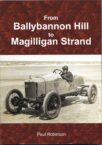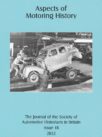
There would be sparse information on the Fafnir car were it not for an article in a 1913 issue of Motor Trader that followed a visit to their factory in the German town of Aachen – although the article used the name Aix-la-Chapelle. This French name was traditionally used by the British at the time; it dates to the late 8th century, when Charlemagne had his palatine chapel built there and then made the city his empire’s capital.
At the close of the nineteenth century the owners of a needle factory in Iserlohn, over 150 km to the east, founded a branch business at Aachen because it was a centre of the needle industry and had a world-wide reputation. The company was founded in 1898 as “Carl Schwanemeyer, Aachener Stahlwarenfabrik AG”. Production started with sewing machine needles, but almost immediately a demand arose for cycle spokes, whose thickened ends needed the same production techniques. This led to the manufacture of wire wheels for motor cars.
The Aachen factory became independent of its Iserlohn parent and moved into the manufacture of engines for motorcycles and motor cars. They also made modern high-speed heavy-oil engines for agriculture and industry. The name “Fafnir” (a dragon from Germanic heroic legend) was first used on the company’s products in 1902. In 1904, Fafnir started to produce kits of engines, gearboxes, final drives and steering gear to allow others, particularly bicycle makers, to enter into motor vehicle production. These were sold under the name “Omnimobil”.
As these customers for Omnimobil kits increasingly started to make their own engines and other components, Fafnir were forced to go into manufacture of cars on their own account – and the first model was introduced in 1908. By 1913 the factory had expanded to over 300,000 sq. ft. and a new power station made use of twenty-five of Fafnir’s own oil engines to drive machine-shop line shafts and to generate electric light.
All cars in the 1913 range were 4-cylinder models, and a British advertisement quoted models from the 11-16 h.p. in our Snapshot up to the 20-35 h.p. In 1919 the pre-war cars were reintroduced, and a new model, the 471 with a 1950cc engine, was added in 1920 and could be bought with a supercharger. Fafnir production methods were very labour-intensive, and the difficult trading conditions of the 1920s drove the company to close in 1926.
Image courtesy of The Richard Roberts Archive: www.richardrobertsarchive.org.uk







Years before Fafnir-built cars came to Britain likely 1908/9, many British motorcycle, car and commercial equipment manufacturers installed Fafnir engines and parts, although the “Omnimobil” parts brand doesn’t seem to appear here. Nevertheless, well-respected they became and a 1912 motor show reporter observed: “there is not a motorcyclist in the land who would not doff his cap to the Fafnir engine.”
Motorcycle maker Triumph certainly doffed theirs, fitting Fafnir air-cooled motors before 1904 and later admitting to basing their own first engine design on them that year. Some Royal Enfields were sold with a 2 h.p. Fafnir and lesser-known Acacia, Beau, Bell, Chater-Lea, Cheviot, Dene, Dreadnought, Ideal and Jesmond used them. Raleigh did too, notably a water-cooled 3.5 h.p. in their 1905 “Raleighette Tri-car” – its engine speed was limited by an exhaust governor and carrying 30-stone it could reach 30mph on the level but a one-in-seven hill had all passengers pushing.
1905 saw the Addison Motor Co. of Liverpool’s £75, coach-built, chain-driven three-wheel “Fore-car”, with its 3.5 h.p. Fafnir water-cooled engine – second-hand sales show that quite a lot of these 3-seaters were purchased. They also sold a belt-drive, air-cooled, 3.5 h.p. Fafnir-engined motorcycle using Chater-Lea parts for £37 10s.
Small British car constructors were possibly as quick to use them: in April 1903, the Ariel “Swift” car was advertised with a 4.5 h.p. Fafnir engine, soon raised to 7-9 h.p. Three horse-power, Ariel motorcycles with Fafnir engines were also on sale but unclear which of these were French-built or by companies in Reading or Coventry. An Ariel company of Reading was definitely selling its Swift car with a Fafnir two-cylinder engine by 1906; whenever a Swift was subsequently sold second-hand, it was usually described as fitted with a Fafnir engine.
In 1905 also in Reading, the British Motor and Engineering Company, Caversham Bridge started manufacturing its cars with Fafnir motors: a 100-guineas 6ft. 4in. wheelbase, 2-seater with a 7 h.p. two-cylinder engine; a 200-guineas, 10-12 h.p. four-cylinder tonneau and a 14 h.p. for 250-guineas, all with a patented four-speed gate-change, constant-mesh gearbox. The starting handle for these cars was on the dashboard. Disingenuously they marketed it as “The British”, claiming they could not find a British-built engine of the same quality as the Fafnir for the same price; the company soon disappeared.
The 1906 Barnes 4-cylinder, 2-seater, live-axle light car made by the Magneto Motor Manufacturing Co. of Lewisham used a 10 h.p. Fafnir; it was 250-guineas or 3-guineas more for a 4-seater. The made-in-Altrincham, 1906 New Eagle, 10-12 h.p. car had a Fafnir motor.
The 1906 “Quadcar” by Phoenix Motors of Kings Cross used a two-cylinder Fafnir and when taken over by J. van Hooydonk in 1907 became the £140 Phoenix chain-drive light car with an 8 h.p. water cooled two-cylinder Fafnir which was tested, he claimed, at 1600RPM for ten hours before fitting in the car. Even Henry Sturmey and S. F. Edge praised this model. The Victoria Motor Works at Godalming also turned out some 10 h.p. Fafnir-engined light cars with Marconi coils and accumulators in 1907 and the 3.5 h.p. Fafnir-engined Zenith Bi-car was £26 in 1908. There were probably more users as it was common not to name the engine supplier in specifications.
One notable British customer which did was “Pullcar” of Preston, maker of the new Hansom-like 1906 front-wheel drive London Metropolitan cab. Under the driver’s seat of the first version was a transverse-mounted Fafnir 12-14 h.p. four-cylinder and a gearbox, which drove by chain a differential with universally jointed axle shafts to the front wheels. It was probably under-powered and when bankrupt in 1908, the company was using an 18 h.p. White and Poppe.
Fafnir parts appeared in other vehicles: in 1906, West Cars Ltd. of Coventry fitted some cars with a Fafnir three-speed and reverse gearbox and an Aster engine. There was even a three-ton agricultural roller made then, with a 2-cylinder Fafnir Engine and a reversible two-speed gearbox; also, a 3 h.p. wood splitter. However, it would seem few if any heavy oil engines came to Britain but a number of speedboats and launches did use marinized 16 to 24 h.p. petrol Fafnirs.
The good reputation of the engines seems to have been such that some cars were marketed under their name much earlier, as in April 1903 Cripps of Nottingham listed a “Second hand, 8/10-H.P. Fafnir, 2-cylinders, £156”. In 1905, the same company had a “nearly-new”, convertible two/four-seater, two-cylinder, 10 h.p. Fafnir car for £130. Perhaps this was just careless marketing of unheard-of cars by their more sales-worthy Fafnir engine name but just a couple of years on a Fafnir 10-12 h.p. car was reported ferrying a children’s day out in Smethwick in September 1907 and 1908 saw a 7 h.p. Fafnir car competing in a Derbyshire trial.
Definitively Fafnir-made cars were advertised by “Frome-Selwood Motor Works; Agents for Fafnir cars and components” in the West of England in spring 1909 when they were described as well-known – the 15-16 h.p. being rated “the cheapest high-class car on the market.” That year, many Fafnir cars were on sale second hand in that region. Some early cars had 10-12 h.p. or 12-16 h.p. engines with respective bores and strokes of 80x125mm and 100x125mm, their cylinders reportedly cast separately with rocker-operated overhead inlet valves. Road tests in December commented on the 12-h.p. having “good design and a harmonious blending of parts.”
Concessionaires Messrs. G. Strauss of Thames-street London, describing Fafnirs as being on the British market for some years in November 1910, offered at the motor show a 12-14 h.p. still with separate cylinders of 70x100mm and the new 16-18 h.p., with pair-cast cylinders, 80x125mm. An 11-16 h.p. for 1911/12 had a new 4-speed gearbox with a clutch brake to smooth-out changes, suggesting it wasn’t constant mesh – gearboxes had “FAFNIR” boldly cast into their top cover. A latter model’s chassis was £330 and coach-built, just £383.
Importer from May 1911, Messrs. John Barkers of London, built a smart torpedo-bodied tourer using a £285, 16-20 h.p. chassis, which had pair-cast cylinders 100x125mm, with side-valves on the same side and unusually by this time, bronze alloy plain bearings rather than white metal but it did have a pedal controlled twin-jet carburettor and a wheelbase/track of 9ft 6in/4ft 6in.
In 1913, Fafnir agents could offer “an 11/16 H.P. suitable for two seaters or light 4 seaters; a 12/20 H.P. suitable for 2 & 5 seaters and Light Delivery Vans; 16/25 H.P. suitable for Cabriolets, Landaulettes and Touring Cars; a 16/25 Special for Delivery and Ambulance Vans and all types of Touring Bodies and a 20/35 H.P. suitable for all Types of Bodies for large Cars and Vans. Prices from £238 to £800, complete Cars.” That year’s 11-16 h.p. with a two-seater body was £238, as sold by George E. Duerden of Burnley.
After WWI, Fafnir engined motorcycles of up to 4 h.p. continued to be widely advertised for sale new and second-hand, much more so than Fafnir-engined cars.